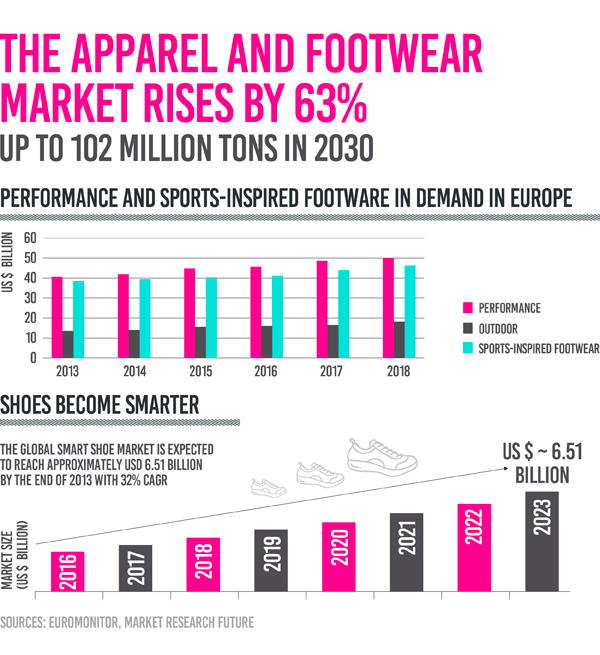![]() 6 minute read
6 minute read
The global athletic footwear market will exceed 110 billion dollars by 2025. Footwear innovators are turning shoes into carry-on health monitors with additional comfort features. Additionally, the sustainability trend has spread into the shoe industry, enabling new designs to be bought with a better conscience.
Athleisure is not just a trend
“Sportswear is of growing importance and influence at the moment as it is reflective of the way we live our lives,” says Reebok. “The function and comfort of sportswear fabrics and cuts lend themselves to fast-paced life very well.” Indeed, people increasingly value comfort and health benefits from their footwear. This choice of athleisure has been created by a change of lifestyle. People tend to be more on the go and enjoy more active leisure time, which influences footwear choices to be more comfort-oriented. In the US, the sales of so-called sport leisure shoes have risen 17% in 2017, whereas sports performance footwear has been on an annual decline of 10%. This suggests that as much as consumers value their comfort, they do not sacrifice it for the style. Instead, the features need to be combined. Matt Powell, sports industry advisor at NDP, commented on the athleisure trend: “I often get asked whether the bubble around leisure will burst anytime soon, and the answer is no. Athleisure rules the runway, and the line between what is an athletic shoe and a casual shoe continues to blur. Brands and retailers must continue to feed this trend.”

Features for inner comfort
Because consumers desire comfort, footwear designers have taken their innovations further to provide it as easily as possible. With cross-industry cooperation, everyday problematic issues like sweating and unraveling laces can be solved. There are now shoes with embedded heating and massage pads, as well as automatically fastening features. It is expected that, in the future, shoes will even contain technology that will stimulate nerves to improve health.
Heat is not always comfortable in shoes due to sweating and the resulting odor. Therefore, MIT and New Balance have created a material called bioLogic. It is a smart fabric that has been infused with bacteria that control the movement of ventilation panels in the fabric by reacting to temperature differences. The bacteria open up the panels when the shoe becomes warm enough, and conversely closes the panels when the temperature has decreased enough.
Another weapon in the battle against perspiration has been offered by a team of Australian researchers who found a way to deal with heat issues with graphene oxide. This material absorbs moisture efficiently, thus, controlling for the moisture and odor caused by sweating in shoes. Furthermore, the moisture can then be removed from footwear with household appliances, thus controlling for the smell without washing them or using specialized deodorants.
A shoe as perfectly
fitted as Cinderella’s
“Millennials and Gen Xers are more interested in individualized products than a logo,” said Jason Goldberg, SVP of commerce and content practice at Razorfish. “Younger demographics want personalized and unique products.” One way of offering personalized footwear is with 3D technology. 3D scanning helps customers get the perfect fit. Companies such as New Balance use Volumental, which is a 3D scanning technology that uses RealSense cameras to analyze feet, and then offers recommendations on shoe models that suit the individual.
Likewise, an app called Fitfully offers a similar service for private customers who want to do their shoe shopping online. The app shows a pressure map of how a foot will fit specific shoe models. Multiple brands also currently use 3D scanning to produce, not the whole shoe yet, but a customized midsole. ECCO, as an example, uses 3D scanning and wearable sensors in test shoes to create a 3D model of the best fitting midsole that is then 3D printed. The whole process takes only a few hours and provides the consumer with the best fitting shoes.
Smart sensors
navigating the living
With the constant development of sports sensors and gadgets, footwear has not been left out of the picture. Soft sensor networks are circuits of flexible sensors that have been embedded into shoes to measure biomechanical data. The information helps individuals keep track of their movement habits and, in the best case, it can help prevent injuries. For example, Stridalyzer is an insole that identifies force and pressure and thus can help in injury prevention. Additionally, shoes have been developed to have pedometers and GPS systems implemented in them. HP, for instance, invented Lechal haptic footwear that works as a navigation system when they are connected to a smartphone via Bluetooth. The shoes then vibrate to tell the direction in which the user should go.
Another way of making shoes smart is by embedding a screen into them. Shiftwear is a company that allows the user to control and change what picture or video is shown on a flexible full HD color display on their shoes. The screen is charged with kinetic energy while walking, and the shoes are both waterproof and resistant to stains. Shiftwear has revolutionized the customization market for footwear by letting wearers communicate their style, opinions, and values in a moving image.
Sustainable and
ethical production
On their way to a sustainable future, most of the larger companies have changed their ways of production to be more environmentally friendly. The current trend is tackling plastic pollution via recycling. Vivobarefoot has designed a line of shoes where each pair is made of 17 recycled water bottles. Timberland not only collects plastic waste to be reused but also in doing this they offer jobs to those in need. Adidas has also taken their step towards the cause by promising to only use recycled for their products by 2024.
Allbirds offers another kind of sustainable option for footwear production. They introduced a new collection of footwear made of Eucalyptus pulp, called “Tree collection”. Production of the material uses only 5% of the water and a third of the land space typically used to create typical footwear materials. The company also uses the most rigorous sustainable forestry standard in order to protect trees, wildlife, and people. These shoes are especially comfortable in warm weather as the material naturally lets moisture out.




